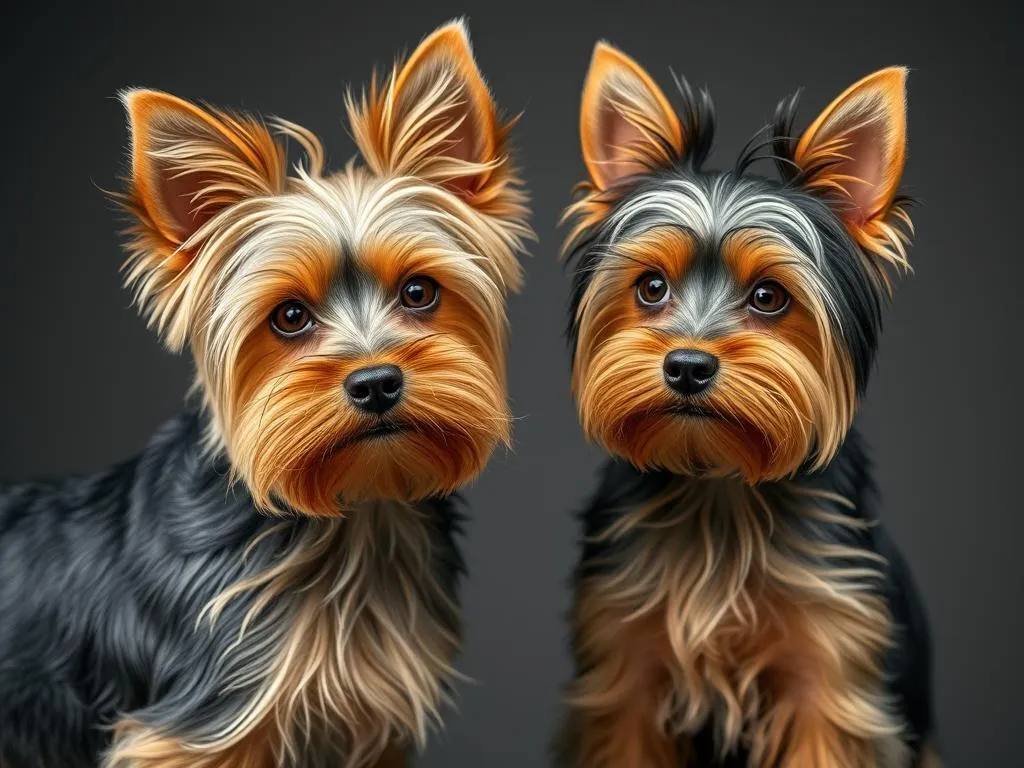
Introduction
Yorkshire Terriers, affectionately known as Yorkies, have captured the hearts of dog lovers around the world. Originating in the 19th century in England, these small yet spirited dogs were initially bred to catch rats in clothing mills. Today, they are beloved companions known for their intelligence, loyalty, and distinctive long, silky coats. With their charming personalities and compact size, Yorkies have become one of the most popular toy breeds.
When choosing a Yorkshire Terrier, potential dog owners often wonder about the differences between male Yorkshire Terriers vs female Yorkshire Terriers. This comparison will explore various aspects, from physical characteristics and temperament to health considerations and lifestyle compatibility, to help you make an informed decision.
Physical Characteristics
Size and Weight
When it comes to size, male and female Yorkshire Terriers are relatively similar, but there are some distinctions. On average, male Yorkies tend to be slightly larger than their female counterparts. Males typically weigh between 4 to 7 pounds, while females generally range from 3 to 6 pounds.
This weight difference can have practical implications for care. For instance, larger males may require slightly larger harnesses and collars, and they may be more prone to certain health issues due to their size. Understanding these dimensions can be crucial for potential owners when preparing their homes and selecting the right supplies for their new pet.
Coat and Grooming
One of the most striking features of Yorkshire Terriers is their luxurious coat. Both male and female Yorkies have the same silky, long hair that requires regular grooming to prevent matting and tangling. However, males often have thicker fur, which may need more frequent grooming sessions than females.
In terms of shedding, Yorkies are considered low-shedding dogs, making them a suitable choice for allergy sufferers. However, individual dogs may vary, and grooming habits can influence the amount of hair that ends up around the house. Regular brushing and visits to a professional groomer are essential for maintaining their beautiful coats.
Distinctive Features
While both male and female Yorkies share a similar overall appearance, there are some subtle differences. Males may have a slightly more robust facial structure, while females often exhibit a more refined appearance. Additionally, males might have larger ears, which can contribute to a more alert look.
These physical distinctions can be minor, but they may influence a potential owner’s decision in choosing between male Yorkshire Terriers vs female Yorkshire Terriers.
Temperament and Behavior
General Temperament
Yorkshire Terriers are known for their vibrant and affectionate personalities. They are playful, energetic, and often see themselves as much larger than their actual size. However, there can be slight variations in temperament between males and females.
Males are generally known to be more outgoing and social, while females can exhibit a more nurturing and protective nature. This does not mean that all males or females will fit these stereotypes, but potential owners should be aware of these general tendencies when making their choice.
Social Behavior
The social behavior of Yorkshire Terriers can also differ between genders. Male Yorkies may display tendencies towards dominance and aggression, particularly if they are not neutered. They might be more inclined to challenge other dogs, especially if they feel threatened.
On the other hand, female Yorkies are often more nurturing and may exhibit mood swings, especially during their heat cycles. They tend to be more cautious and observant, which can make them great companions for families with children. Understanding these behavioral traits is vital for potential owners to create a harmonious environment at home.
Trainability
Trainability is another essential aspect of owning a Yorkshire Terrier. In general, both male and female Yorkies are intelligent and eager to please, making them relatively easy to train. However, males can sometimes be more stubborn and less focused, especially if they are distracted by other stimuli.
To effectively train male Yorkies, consistency and positive reinforcement are key. Females, while also trainable, might be more responsive to commands and social cues. Tailoring your training approach to each gender’s unique traits can enhance the learning experience for both the dog and the owner.
Health Considerations
Common Health Issues
Health is a significant consideration for any dog owner. Yorkshire Terriers, regardless of gender, are susceptible to certain health issues, including dental problems, patellar luxation, and hip dysplasia. However, there are some differences in health concerns between male and female Yorkies.
Males may be more prone to developing urinary stones and certain reproductive health issues, while females can face complications related to pregnancy and heat cycles. Understanding these differences can help owners take preventive measures to ensure their Yorkie’s long-term health and well-being.
Reproductive Health
Spaying and neutering are common practices among pet owners, and they can significantly affect a Yorkie’s behavior and health. Neutering male Yorkies can help reduce aggressive tendencies and eliminate the risk of certain health problems, such as testicular cancer.
For female Yorkies, spaying can prevent unwanted litters and reduce the risk of breast cancer and uterine infections. However, both procedures may lead to some behavioral changes, such as decreased energy levels or changes in temperament. Owners should consult their veterinarians to understand the best timing and approach for their pet.
Veterinary Care
Regular veterinary care is crucial for maintaining the health of any Yorkshire Terrier. Routine check-ups, vaccinations, and preventive care should be prioritized for both males and females. Owners should also keep an eye on dental health, as Yorkies are prone to dental issues due to their small mouths.
Creating a health plan that includes regular vet visits and preventive measures can help ensure a long, healthy life for your Yorkie, regardless of gender.
Lifestyle Compatibility
Family Dynamics
When considering whether to adopt a male or female Yorkshire Terrier, family dynamics play an important role. Males often thrive in active families with children, as their playful nature can keep up with energetic kids. However, it’s essential to supervise interactions to ensure that both the children and the dog are safe.
Females, on the other hand, can be excellent companions for families, particularly those with younger children. Their nurturing behavior makes them more inclined to be gentle and protective. Owners should assess their family situation and lifestyle when deciding between male Yorkshire Terriers vs female Yorkshire Terriers.
Activity Level
Both male and female Yorkies are known for their high energy levels, but there can be differences in how they express this energy. Males may be more prone to hyperactivity, while females might display a more balanced approach to play and rest.
In terms of living situations, both genders can adapt well to apartment living, provided they receive adequate exercise. Daily walks and playtime are essential for keeping your Yorkie healthy and happy. Understanding your dog’s energy levels can help you create a suitable daily routine.
Owner Experience Level
When selecting a Yorkshire Terrier, a potential owner’s experience level is another important factor. First-time dog owners may find female Yorkies easier to train and manage due to their generally more responsive nature. Males can be a bit more challenging, especially if the owner is unfamiliar with dog training.
However, seasoned dog owners may appreciate the boldness and personality of a male Yorkie. Choosing the right gender can enhance the owner-dog relationship and contribute to a rewarding companionship.
Cost and Maintenance
Initial Purchase Price
When it comes to the initial purchase price, male and female Yorkshire Terriers can vary, but the differences are generally minimal. On average, a purebred Yorkie can cost anywhere from $1,000 to $3,000, with factors such as pedigree and breeder reputation influencing the price.
In some cases, male Yorkies may be slightly more expensive due to their larger size or breeding potential. However, potential owners should focus on finding a reputable breeder rather than getting caught up in price differences.
Ongoing Maintenance Costs
Grooming is a significant ongoing expense for Yorkshire Terriers, regardless of gender. Male Yorkies may require more frequent grooming sessions due to their thicker coats, which can add to the overall maintenance costs. Grooming can range from $50 to $100 per visit, depending on the services provided.
In addition to grooming, owners should consider health care and nutrition expenses. High-quality dog food, routine veterinary visits, and preventive care are essential for keeping your Yorkie healthy. Understanding these costs can help owners budget for their pet’s needs over the long term.
Personal Stories and Testimonials
Owner Experiences
Many Yorkie owners have shared their experiences with male and female dogs, highlighting the unique traits of each gender. For instance, one owner mentioned that their male Yorkie was more outgoing and loved to greet every visitor, while their female was more reserved but incredibly loyal and affectionate towards family members.
Another owner shared how their female Yorkie provided comfort during tough times, often snuggling up close and sensing their emotions. These stories illustrate the varied experiences that come with owning a male or female Yorkshire Terrier.
Expert Opinions
Veterinarians and dog trainers often emphasize the importance of understanding the differences between male and female Yorkies. Experts recommend that potential owners consider their lifestyle, family dynamics, and preferences when making a choice. They also stress the significance of socialization and training to shape a Yorkie’s behavior, regardless of gender.
Conclusion
In summary, both male Yorkshire Terriers vs female Yorkshire Terriers possess unique characteristics and traits that can appeal to various dog owners. Males may be more outgoing and playful, while females often display nurturing tendencies and a gentle demeanor.
Ultimately, the choice between a male or female Yorkie should align with your lifestyle, family dynamics, and personal preferences. By understanding the differences and similarities between the genders, potential owners can make an informed decision that leads to a fulfilling and loving companionship with their new furry friend.









